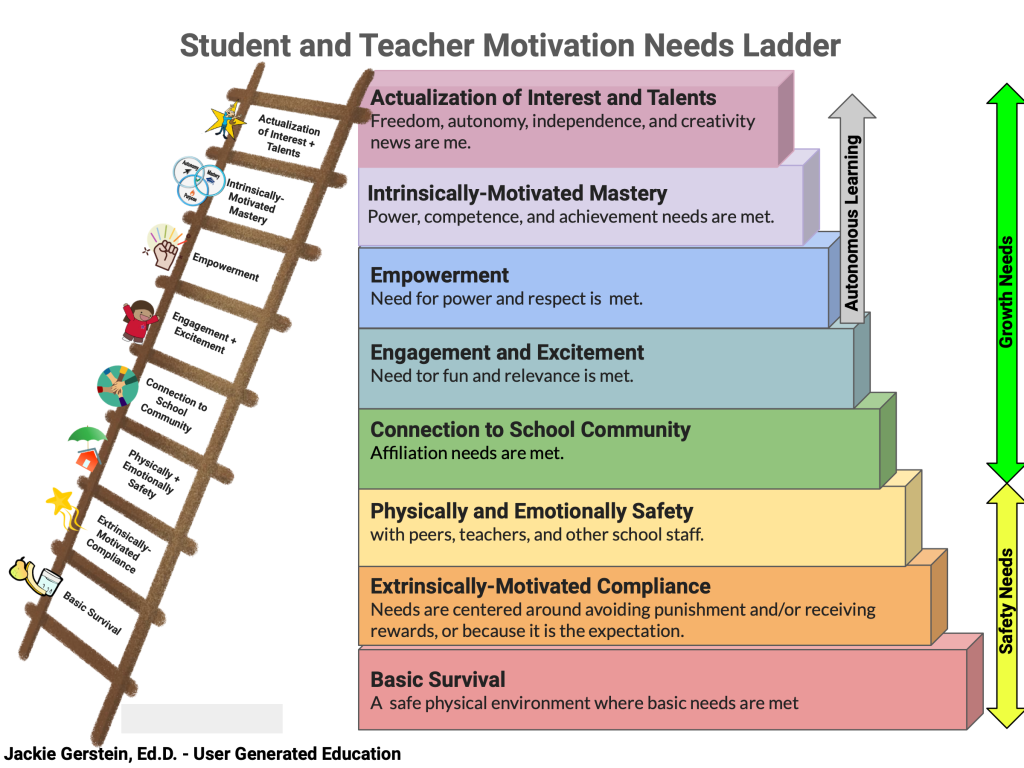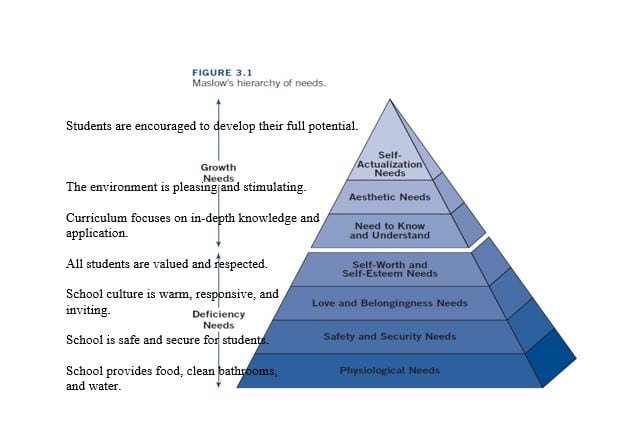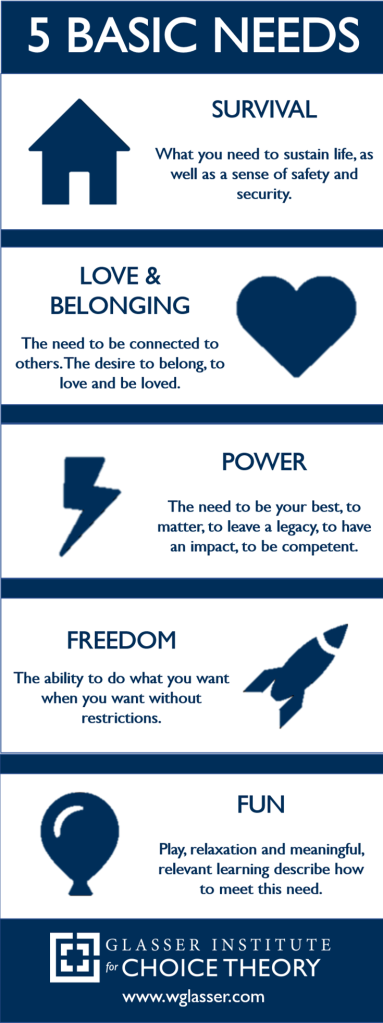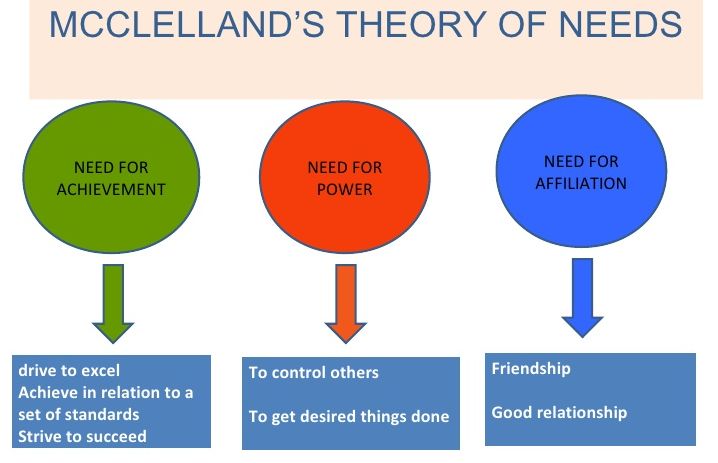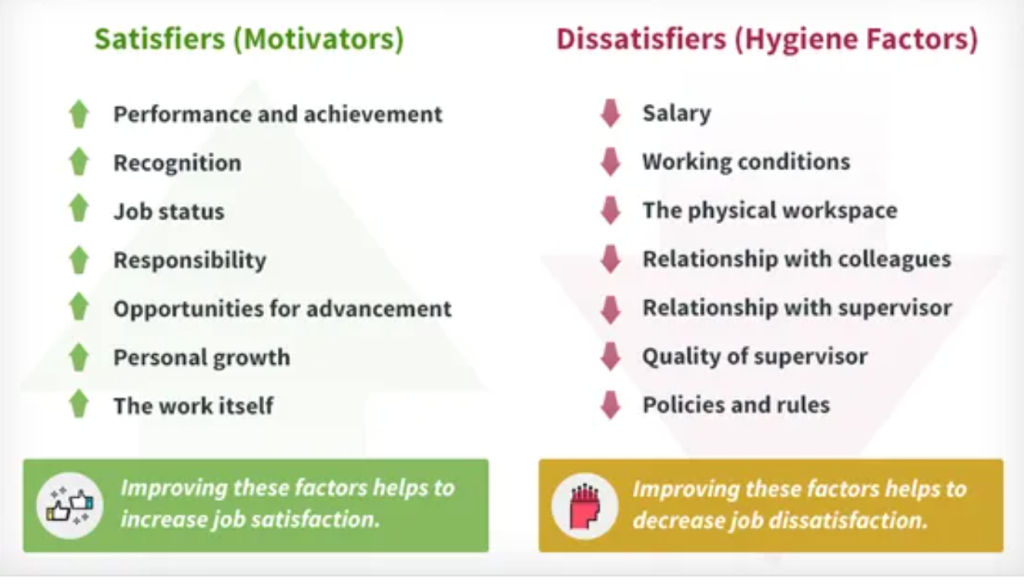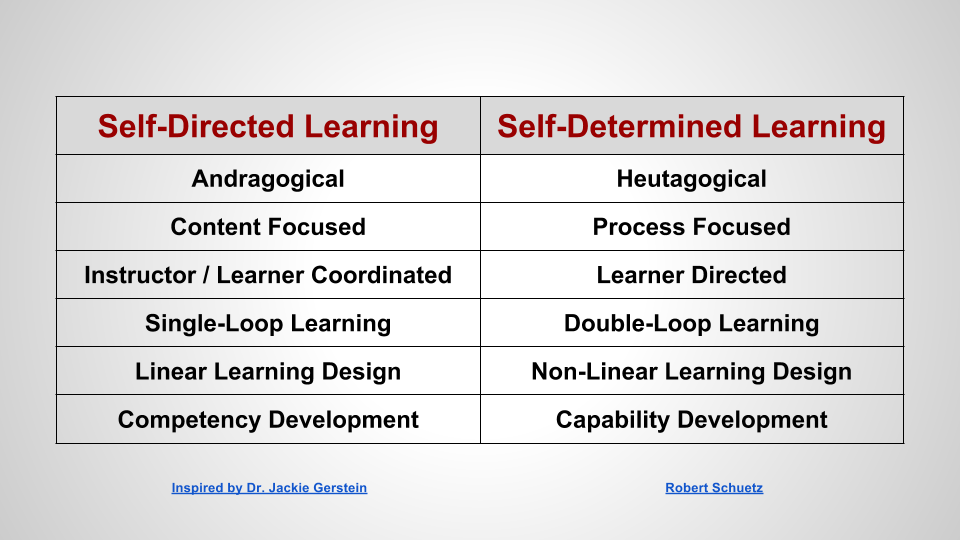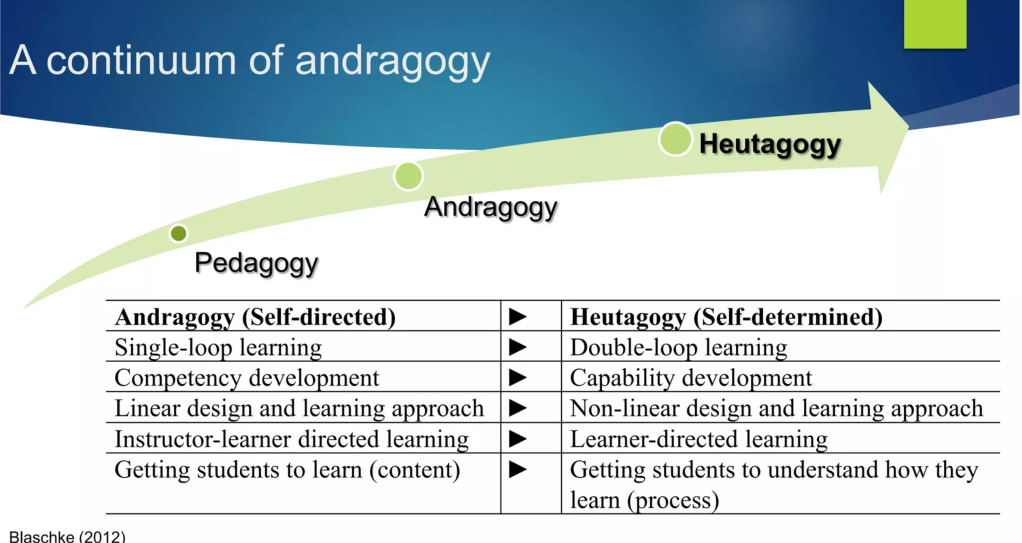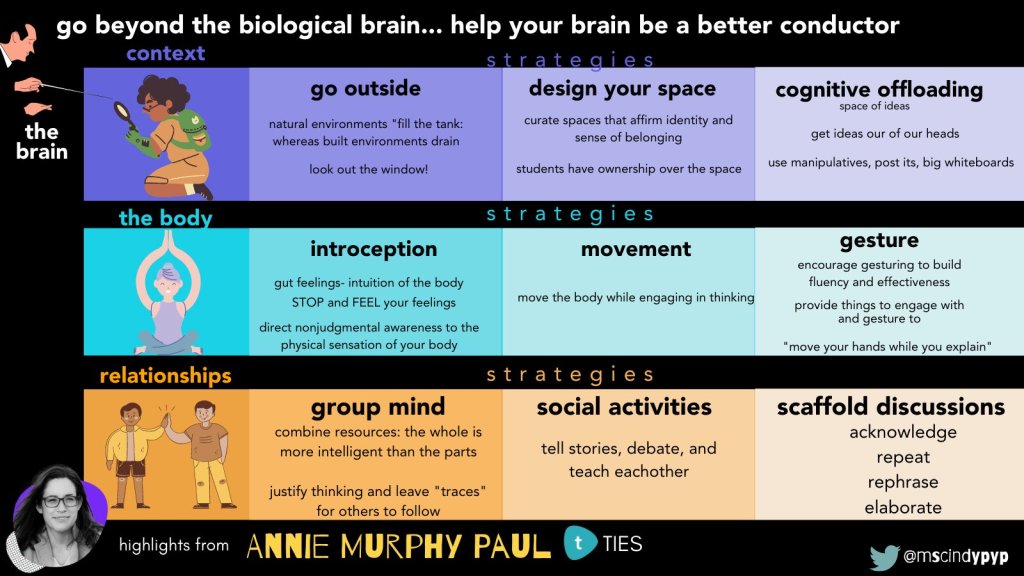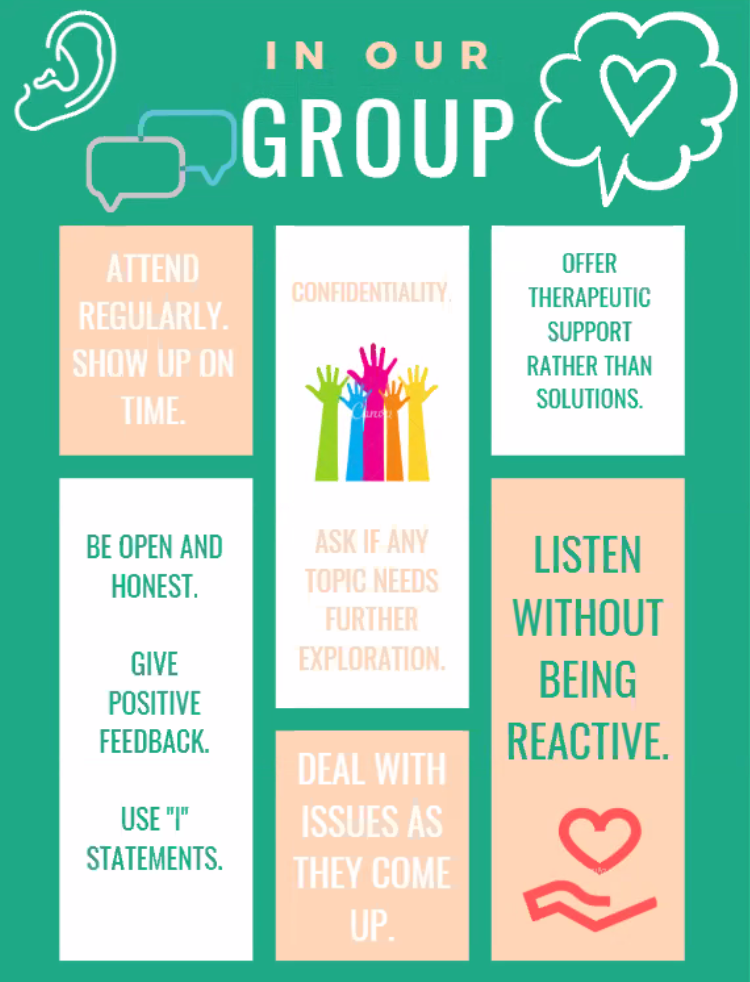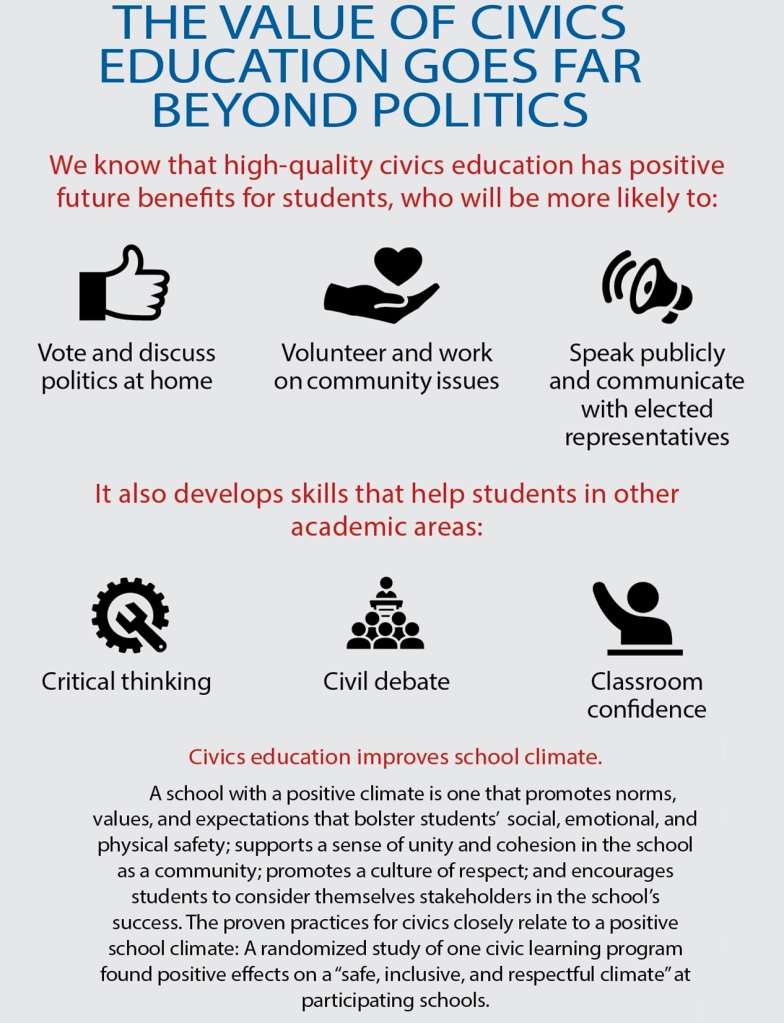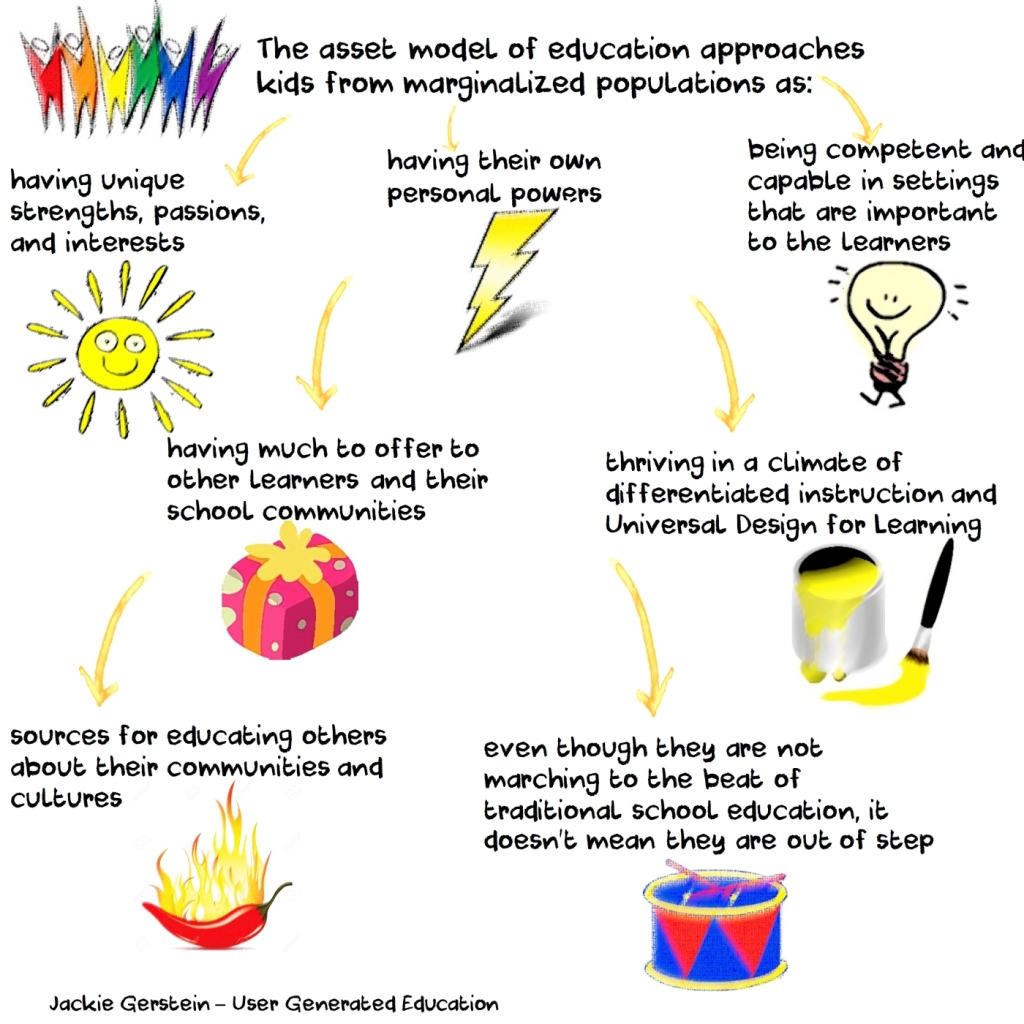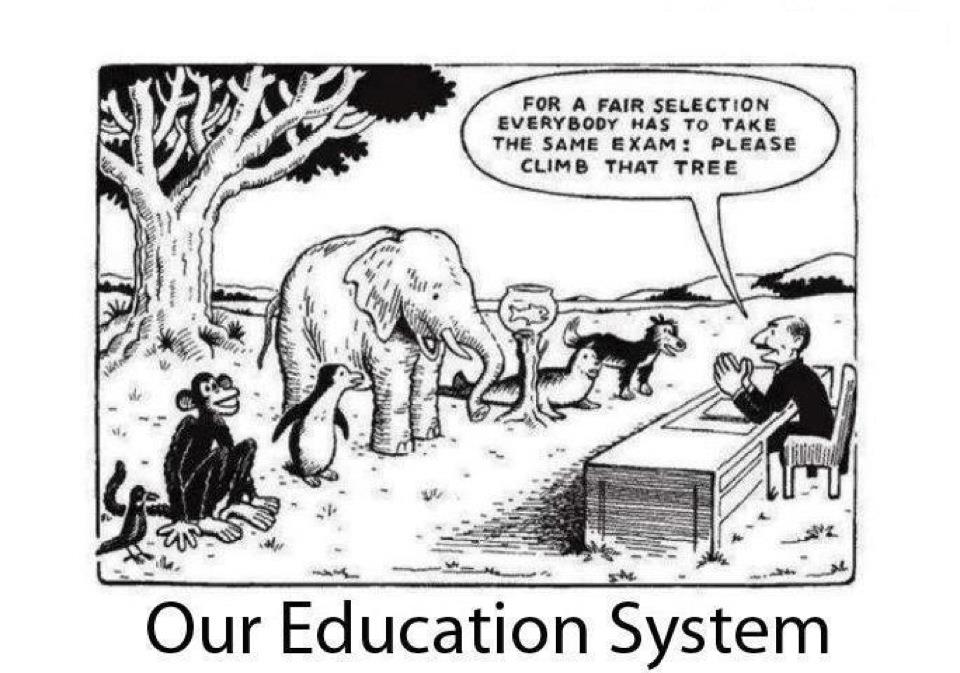Posts Tagged ‘school reform’
The Extended Mind: The Power of Thinking Outside the Brain by Annie Murphy Paul (A Guide for Educators)
As an educator who . . . began my career as an outdoor and experiential-based counselor; loves and studies educational trends; and teaches elementary students, and pre-service and in-service teachers; I believe good teachers naturally do what’s best for their students. This is in spite of (all meanings intended) of the multiple, and often conflicting and changing mandates placed on them.
With that said, I was excited to hear Annie Murphy Paul discuss her new book, The Extended Mind: The Power of Thinking Outside the Brain, at toddle TIES.
Over many years of elementary school, high school, and even college and graduate school, we’re never explicitly taught to think outside the brain; we’re not shown how to employ our bodies and spaces and relationships in the service of intelligent thought. Yet this instruction is available if we know where to look; our teachers are the artists and scientists and authors who have figured out these methods for themselves, and the researchers who are, at last, making these methods the object of study. For humans these [methods] include, most notably, the feelings and movements of our bodies; the physical spaces in which we learn and work; and the other minds with which we interact—our classmates, colleagues, teachers, supervisors, friends. (https://www.amazon.com/Thinking-Outside-Brain-Annie-Murphy/dp/0544947665)
From The Harvard Book Store:
The Extended Mind outlines the research behind this exciting new vision of human ability, exploring the findings of neuroscientists, cognitive scientists, psychologists, and examining the practices of educators, managers, and leaders who are already reaping the benefits of thinking outside the brain. She excavates the untold history of how artists, scientists, and authors—from Jackson Pollock to Jonas Salk to Robert Caro—have used mental extensions to solve problems, make discoveries, and create new works.
What we need to do, says acclaimed science writer Annie Murphy Paul, is think outside the brain. A host of “extra-neural” resources—the feelings and movements of our bodies, the physical spaces in which we learn and work, and the minds of those around us— can help us focus more intently, comprehend more deeply, and create more imaginatively.
In this book, she proposes a series of strategies that for me reflect best practices in education and ones that I typically use with my students (of all ages) on a regular basis. As mentioned earlier, I believe good educators often naturally integrate these practices in their classrooms:
created by Cindy Blackburn
Here is an written summary of these keys points and strategies:
Source: https://jenniferlouden.com/wp-content/uploads/2021/07/Paul.THE-EXTENDED-MIND.list-of-takeaways.pdf
What are the characteristics of high performing schools?
I am in the unique position of having several types of education jobs. I teach online graduate courses in educational technology to in-service teachers. I am a cohort facilitator for student teachers; and I am a part-time gifted teacher of elementary students at two different elementary schools that serve Kindergarten through 6th grade students. Out of the 16 elementary schools in my town, these two schools have some of the lowest end-of-year standardized test scores in the entire district; are composed of 85% to 90% Hispanic students; have a high percentage of English Language Learners; and all students on free or reduced lunch. These statistics present a dire picture, don’t they?
I tell my student teachers that when they enter new schools for possible employment, they should be able to see and feel the culture of the school almost immediately upon entering the front doors. Because of this belief, I decided to do a photo essay of the artifacts found on the hallway walls at the schools where I teach:
Because of the variety of my jobs as well as being an active reader and contributor to social media, I do a lot of thinking and reading about the qualities of high performing schools. Again, the data shows that I work at very low performing schools, but how are intangibles measured? How are the following characteristics, which I see, hear, and feel at both of my schools, measured and quantified?
- A positive school climate
- A safe school climate
- Dedicated teachers who love teaching and their students
- Creative teachers
- Students enjoyment of being at school and in learning
- Student creativity and imagination
- Lots of laughing and smiling students
- The arts naturally integrated into content area learning
- School walls filled with beautiful student artifacts
I wholeheartedly believe I am teaching in high performing schools.
Natural Differentiation and Personalization Through Open Ended Learning Activities
This past summer I facilitated maker education classes for 5 to 10 year old kids. This school year I am a gifted teacher meeting with 2nd through 6 grades one day per week per group. I like mixed age groups and have no problem designing learning activities for them. I realized that the reason for this is that these activities are open ended permitting each student to naturally and instinctively to work at or slightly above his or her ability level. This actually is a definition of differentiation.
Many classrooms consist of students from different knowledge backgrounds, multiple cultures, both genders, and students with a range of disabilities or exceptionalities (Alavinia & Fardy, 2012). Differentiated instruction is defined as “a philosophy of teaching that is based on the premise that students learn best when their teachers accommodate the differences in their readiness levels, interest, and learning profiles” (Konstantinou-Katzi et al., 2012, p. 333). (in http://edutechwiki.unige.ch/en/Differentiated_learning)
One of results or consequences of providing such activities is an increase in learner engagement, excitement, and motivation. Open ended learning activities permit and encourage learners to bring their “selves” into the work. They become agents of their own learning.
Because of this freedom, they often shine as true selves come through. Learners often surprise both the educator and themselves with what they produce and create. It becomes passion-based learning. Not only do the activities become self-differentiated, they become personalized:
Personalization only comes when students have authentic choice over how to tackle a problem. A personalized environment gives students the freedom to follow a meaningful line of inquiry, while building the skills to connect, synthesize and analyze information into original productions. Diane Laufenberg in What Do We Really Mean When We Say ‘Personalized Learning’?
Personalized learning means that learning starts with the learner. Learning is tailored to the individual needs of each learner instead of by age or grade level. It is more than teaching to “one size fits all” or just moving to learner-centered learning and changing instruction. Personalized Learning takes a holistic view of the individual, skill levels, interests, strengths and challenges, and prior knowledge. The learner owns their learning. Barbara Bray in What is Personalized Learning?
The educator, in this environment, introduces the activities and then steps back to let the learners take over their own personal learning. The educator lets go of expectations what the final produce should be; should look like; should do. The educator becomes a provider of resources, feedback giver, and communications facilitator. S/he becomes a tour guide of learning possibilities. S/he shows learners the possibilities and then gets out of the way.
Creating the conditions for self-differentiation and personalization can occur with learning objectives that start with action verbs such: create, write, explore, invent, make, imagine, prepare, build, compose, construct, design, develop, formulate, originate.

Parting Shot: The following is an Animoto I created to show how many forms of making there are, but it also demonstrates what can happen when open ended projects are introduced into the learning environment.
Breaking Things as a Form of Education
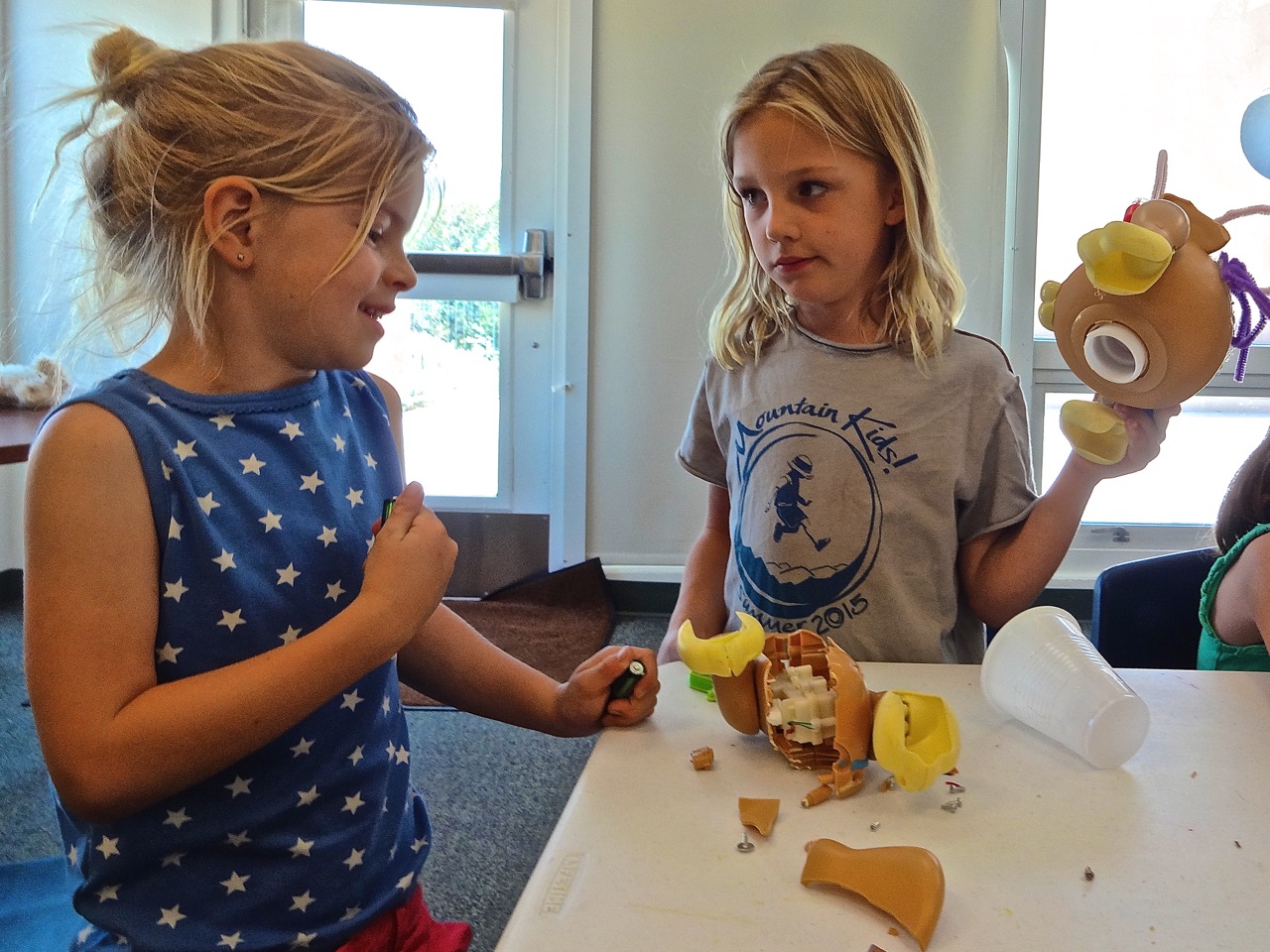
One of my learners’ favorite things to do at my maker education summer camps is taking toys apart – breaking them and then putting back together in another form. This got me thinking that breaking things should be part of every teacher’s and learner’s education. These include:
- Breaking physical objects apart to see their components and how they work.
- Breaking apart how the physical classroom is set up and letting learners help create the setting where they will learn.
- Breaking down barriers of communication . . between educators and learners; between learners and other learners; between the school and parents; between school and the community; between the community of learners and the rest of the world.
- Breaking apart and crushing stereotypes about different genders, ages, ethnicities, and sexual orientation when age appropriate.
- Breaking down walls that keep schools isolated from the world outside of those walls.
- Breaking attitudes that “we’ve always done it that way.”
- Breaking a system that believes children should be grouped by age and grade.
- Breaking (and throwing away forever) the current assessment systems and the related belief that standardized tests actually measure student performance and achievement.
- Breaking apart the idea and practice that children and youth cannot nor should not be teachers.
- And one big NOT . . . NOT breaking the natural passion and excitement that humans have to learn.
These are just my initial thoughts. What would you add to this list of breaking things as a form of education? I want to create an infographic on this list so please add to it!
Maker Education: Pedagogy, Andragogy, Heutagogy
Maker education is currently a major trend in education. But just saying that one is doing Maker Education really doesn’t define the teaching practices that an educator is using to facilitate it. Maker education takes on many forms. This post provides an overview of how maker education is being implemented based on the teaching practices as defined by the Pedagogy, Andragogy, Heutagogy (PAH) continuum.

created by Jon Andrews
Traditionally, Pedagogy was defined as the art of teaching children and Andragogy as teaching adults. These definitions have evolved to reflect teacher practices. As such, andragogical and heutagogical practices can be used with children and youth.
PAH within a Maker Education Framework
The following chart distinguishes and describes maker education within the PAH framework. All teaching styles have a place in Maker Education. For example, pedagogical practices may be needed to teach learners some basic making skills. It helps to scaffold learning, so learners have a foundation for making more complex projects. I do, though, believe that maker education projects and programs should go beyond pedagogical oriented teaching as the overriding goal of maker education is for learners to create something, anything that they haven’t before.
Driving Questions
- Pedagogy – How well can you create this particular maker education project?
- Andragogy – How can this prescribed maker project by adapted and modified?
- Heutagogy – What do you want to make?
Overall Purpose or Goal
- Pedagogy – To teach basic skills as a foundation for future projects – scaffolding.
- Andragogy – To provide some structure so learners can be self-directed.
- Heutogogy – To establish an environment where learners can determine their own goals, learning paths, processes, and products for making.
Role of the Educator
- Pedagogy – To teach, demonstrate, help learners do the maker education project correctly.
- Andragogy – To facilitate, assist learners, mentor
- Heutagogy – To coach, mentor, be a sounding board, be a guide very much on the side.
Making Process
- Pedagogy – Use of prescribed kits, templates; step-by-step directions and tutorials.
- Andragogy – Use of some templates; learners add their own designs and embellishments.
- Heutagogy -Open ended; determined by the learner.
Finish Products
- Pedagogy – A maker project that looks and acts like the original model.
- Andragogy – A maker project that has some attributes of the original model but that includes the learner’s original ideas.
- Heutagogy – A maker project that is unique to the learner (& to the learning community).

Questions Learners Should Be Addressing Every Day at School
I believe it is every educator’s responsibility to help insure that learners are addressing the following questions during each school day:
- What questions am I asking today?
- What answers am I seeking today?
- What am I exploring today?
- What am I making today?
- What am I finding exciting today?
- How am I playing and having fun today?
- How am I using failure to inform my learning today?
- What am I doing today to cooperate with others?
- How am I documenting my learning today?
- How am I sharing with others what I am learning today?
- What am I doing today that has the potential to benefit the world?

